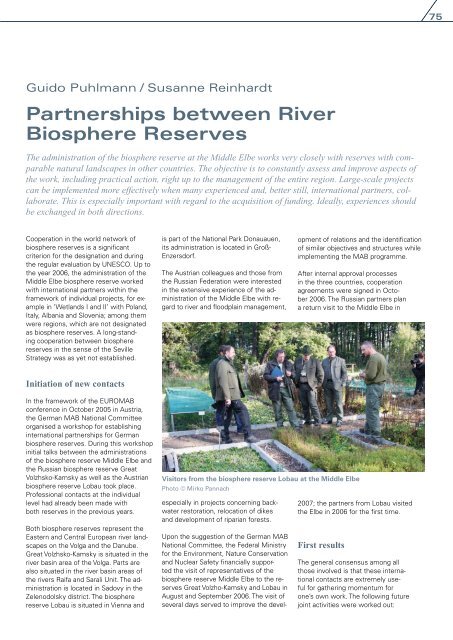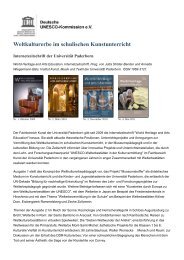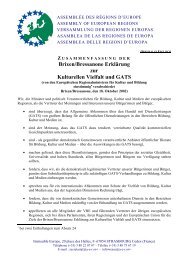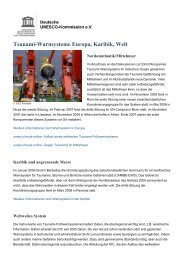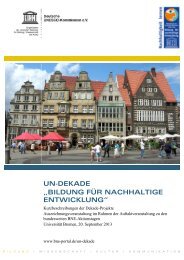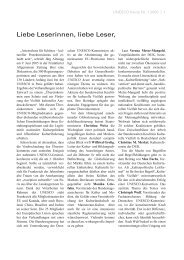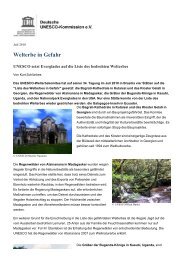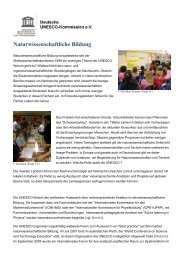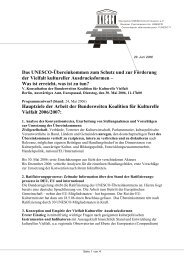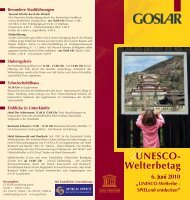Partnerships between River Biosphere Reserves - Unesco
Partnerships between River Biosphere Reserves - Unesco
Partnerships between River Biosphere Reserves - Unesco
You also want an ePaper? Increase the reach of your titles
YUMPU automatically turns print PDFs into web optimized ePapers that Google loves.
Guido Puhlmann / Susanne Reinhardt<br />
<strong>Partnerships</strong> <strong>between</strong> <strong>River</strong><br />
<strong>Biosphere</strong> <strong>Reserves</strong><br />
The administration of the biosphere reserve at the Middle Elbe works very closely with reserves with comparable<br />
natural landscapes in other countries. The objective is to constantly assess and improve aspects of<br />
the work, including practical action, right up to the management of the entire region. Large-scale projects<br />
can be implemented more effectively when many experienced and, better still, international partners, collaborate.<br />
This is especially important with regard to the acquisition of funding. Ideally, experiences should<br />
be exchanged in both directions.<br />
Cooperation in the world network of<br />
biosphere reserves is a significant<br />
criterion for the designation and during<br />
the regular evaluation by UNESCO. Up to<br />
the year 2006, the administration of the<br />
Middle Elbe biosphere reserve worked<br />
with international partners within the<br />
framework of individual projects, for example<br />
in ‘Wetlands I and II’ with Poland,<br />
Italy, Albania and Slovenia; among them<br />
were regions, which are not designated<br />
as biosphere reserves. A long-standing<br />
cooperation <strong>between</strong> biosphere<br />
reserves in the sense of the Seville<br />
Strategy was as yet not established.<br />
Initiation of new contacts<br />
In the framework of the EUROMAB<br />
conference in October 2005 in Austria,<br />
the German MAB National Committee<br />
organised a workshop for establishing<br />
international partnerships for German<br />
biosphere reserves. During this workshop<br />
initial talks <strong>between</strong> the administrations<br />
of the biosphere reserve Middle Elbe and<br />
the Russian biosphere reserve Great<br />
Volzhsko-Kamsky as well as the Austrian<br />
biosphere reserve Lobau took place.<br />
Professional contacts at the individual<br />
level had already been made with<br />
both reserves in the previous years.<br />
Both biosphere reserves represent the<br />
Eastern and Central European river landscapes<br />
on the Volga and the Danube.<br />
Great Volzhsko-Kamsky is situated in the<br />
river basin area of the Volga. Parts are<br />
also situated in the river basin areas of<br />
the rivers Raifa and Sarali Unit. The administration<br />
is located in Sadovy in the<br />
Zelenodolsky district. The biosphere<br />
reserve Lobau is situated in Vienna and<br />
is part of the National Park Donauauen,<br />
its administration is located in Groß-<br />
Enzersdorf.<br />
The Austrian colleagues and those from<br />
the Russian Federation were interested<br />
in the extensive experience of the ad-<br />
ministration of the Middle Elbe with regard<br />
to river and floodplain management,<br />
Visitors from the biosphere reserve Lobau at the Middle Elbe<br />
Photo © Mirko Pannach<br />
especially in projects concerning back-<br />
water restoration, relocation of dikes<br />
and development of riparian forests.<br />
Upon the suggestion of the German MAB<br />
National Committee, the Federal Ministry<br />
for the Environment, Nature Conservation<br />
and Nuclear Safety financially suppor-<br />
ted the visit of representatives of the<br />
biosphere reserve Middle Elbe to the reserves<br />
Great Volzho-Kamsky and Lobau in<br />
August and September 2006. The visit of<br />
several days served to improve the devel-<br />
opment of relations and the identification<br />
of similar objectives and structures while<br />
implementing the MAB programme.<br />
After internal approval processes<br />
in the three countries, cooperation<br />
agreements were signed in October<br />
2006. The Russian partners plan<br />
a return visit to the Middle Elbe in<br />
2007; the partners from Lobau visited<br />
the Elbe in 2006 for the first time.<br />
First results<br />
The general consensus among all<br />
those involved is that these international<br />
contacts are extremely useful<br />
for gathering momentum for<br />
one’s own work. The following future<br />
joint activities were worked out:
UNESCO<br />
today 2|2007<br />
Cooperation <strong>between</strong> UNESCO-designated sites<br />
in Saxony-Anhalt<br />
Saxony-Anhalt is rich in UNESCO-designated<br />
sites representing unique human<br />
cultural achievements and landscapes<br />
of exceptional significance: Dessau and<br />
its Bauhaus, the Elbe <strong>River</strong> floodplains,<br />
Germany’s oldest biosphere reserve and,<br />
nestling <strong>between</strong> Dessau and Wörlitz, the<br />
‘The Garden Kingdom of Dessau-Wörlitz‘.<br />
Also fascinating are the Luther Memorials,<br />
the place of his birth and death in<br />
Eisleben and where he worked on the<br />
reformation in Wittenberg; not far away is<br />
the middle-age old town of Quedlinburg.<br />
Four closely cooperating institutions<br />
are responsible for protecting, maintaining,<br />
developing and communicating<br />
these landscapes and buildings as well<br />
as the exceptional value and brilliant<br />
concepts that they embody: the Bauhaus<br />
Dessau Foundation, the Luther Memorial<br />
Foundations Saxony-Anhalt, the<br />
Cultural Foundation DessauWörlitz and<br />
the Administration of the Middle Elbe<br />
biosphere reserve. Networking and joint<br />
marketing measures have been implemented<br />
by the four institutions for some<br />
time. Cultural politics and area marketing<br />
need a common voice, which can be<br />
heard. Therefore the four UNESCOdesignated<br />
sites regularly coordinate at<br />
executive level, organising joint events<br />
such as the annual ‘Day of the Garden<br />
Kingdom’ (Gartenreichtag) as well as<br />
work together on tourism-programmes<br />
of the federal state Saxony-Anhalt.<br />
This cooperation first became tangible<br />
and evident to the public in 2001 by<br />
the conference ‘Silence’. High level<br />
events have been taking place every<br />
year since then; some examples of<br />
the themes of these events are ‘Genius<br />
loci’, ‘Time’, and ‘Memory’. Most<br />
recently in June 2007, the theme was<br />
‘Myth’. These two-day conferences<br />
were each documented in a book.<br />
The foundations and biosphere reserve<br />
administration have the same goals:<br />
Improving Saxony-Anhalt’s and Dessau’s<br />
external and internal perception, encouraging<br />
sustainable tourism as well<br />
as preserving and developing natural,<br />
cultural and ecological basic resources<br />
on which life depends. Tying the possibilities<br />
and contents of each institution<br />
makes it possible to attain these<br />
goals. The core objective is to realise<br />
the value of the cultural and natural<br />
potential of this region – not only the<br />
economic value. Despite there being<br />
need for further development of our<br />
inheritance, it must first of all be handed<br />
over to future generations unscathed.<br />
• Waterway maintenance<br />
and development;<br />
• Involvement of park rangers in<br />
tourist management, in public relations<br />
and district supervision;<br />
• Beaver management and<br />
beaver research;<br />
• Monitoring and measures<br />
for the European Union programme<br />
NATURA 2000 and<br />
• Involvement of land-users and<br />
the population in the process of<br />
the development of reserves.<br />
Guido Puhlmann is Head of the Administration<br />
of the biosphere reserve Middle Elbe,<br />
at the Administration of the Federal State<br />
Saxony-Anhalt’s part of the UNESCO Elbe<br />
<strong>River</strong> Landscape <strong>Biosphere</strong> Reserve.<br />
Susanne Reinhardt is staff member for public<br />
relations at the administration of the Middle<br />
Elbe biosphere reserve.<br />
Photo © flickr Creative Commons: uli1001
UNESCO <strong>Biosphere</strong> Reserve<br />
Elbe <strong>River</strong> Landscape<br />
The floodplain landscape of the biosphere<br />
reserve along the Middle Elbe spans<br />
3,428 km². It covers the area from the<br />
Middle Elbe lowlands in Saxony-Anhalt<br />
to the north German lowlands in<br />
Schleswig-Holstein in its entirety. The<br />
region was designated by UNESCO in<br />
1997. Its area called Steckby-Lödderitzer<br />
Forst in Saxony-Anhalt was one of the<br />
first biosphere reserves in Germany to<br />
be designated. The course of the river<br />
Elbe is bordered by natural floodplains,<br />
the largest floodplain forests in central<br />
Europe, adjacent deciduous and mixed<br />
forests as well as extensively used<br />
grassland. This biosphere reserve extends<br />
over five federal states; each federal<br />
state has established an own administration:<br />
Schleswig-Holstein, Lower<br />
Saxony, Mecklenburg-Western Pomerania,<br />
Brandenburg and Saxony-Anhalt.<br />
The Elbe valley floodplain is an important<br />
resting and wintering area for swans<br />
and geese. Many farmers consider the<br />
birds to be a threat to their harvest.<br />
The Lower Saxony biosphere reserve<br />
administration has introduced a ‘guest<br />
bird management’ procedure for the<br />
purpose of keeping conflicts with farmers<br />
to a minimum and thus retaining the<br />
Photo © Lutz Möller<br />
Photo © Biosphärenreservat Niedersächsische elbtalaue<br />
significance of the Elbe valley floodplain<br />
as a bird-resting area. Contractual nature<br />
conservation secures undisturbed resting<br />
areas, extensive cultivation methods are<br />
supported and, where possible, power<br />
supply lines are installed underground.<br />
Areas of unharvested cereals are left untouched<br />
to distract birds from the ‘actual’<br />
cultivated areas and whatever losses are<br />
made by the farmers are reimbursed. This<br />
cooperation programme goes to show<br />
that despite the high numbers of geese<br />
using the region as a resting and feeding<br />
area, losses for farmers can be kept low.<br />
An important focus of the work in the part<br />
of the biosphere reserve in Saxony-Anhalt<br />
is the management of wetlands. One of<br />
the most comprehensive projects, boasting<br />
over five million Euros in funding, was<br />
the reconstruction of the lake ‘Kühnauer<br />
See’, an oxbow lake now disconnected<br />
from the Elbe. Through an over-supply of<br />
nutrients it threatened to fill up by sedimentation<br />
and some species had already<br />
disappeared. The lake was thoroughly<br />
desilted and a dam was removed so<br />
that today many species have become<br />
established again in the lake. The Elbe<br />
beaver was threatened with extinction<br />
up to the fifties; it found its last retreat<br />
in the biosphere reserve. The stock was<br />
able to increase up to 1,200 animals.<br />
Further information:<br />
http://www.elbtalaue.niedersachsen.de<br />
http://www.mittelelbe.com<br />
http://www.elbetal-mv.de<br />
http://www.grossschutzgebiete.<br />
brandenburg.de


